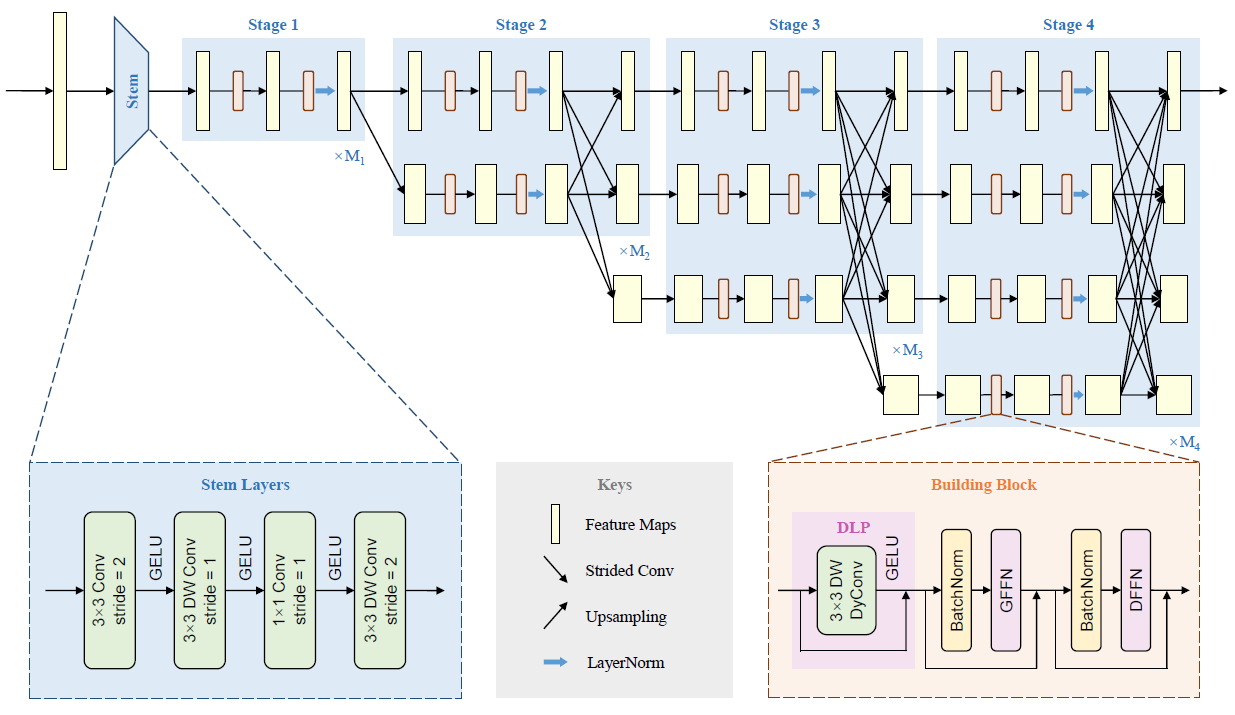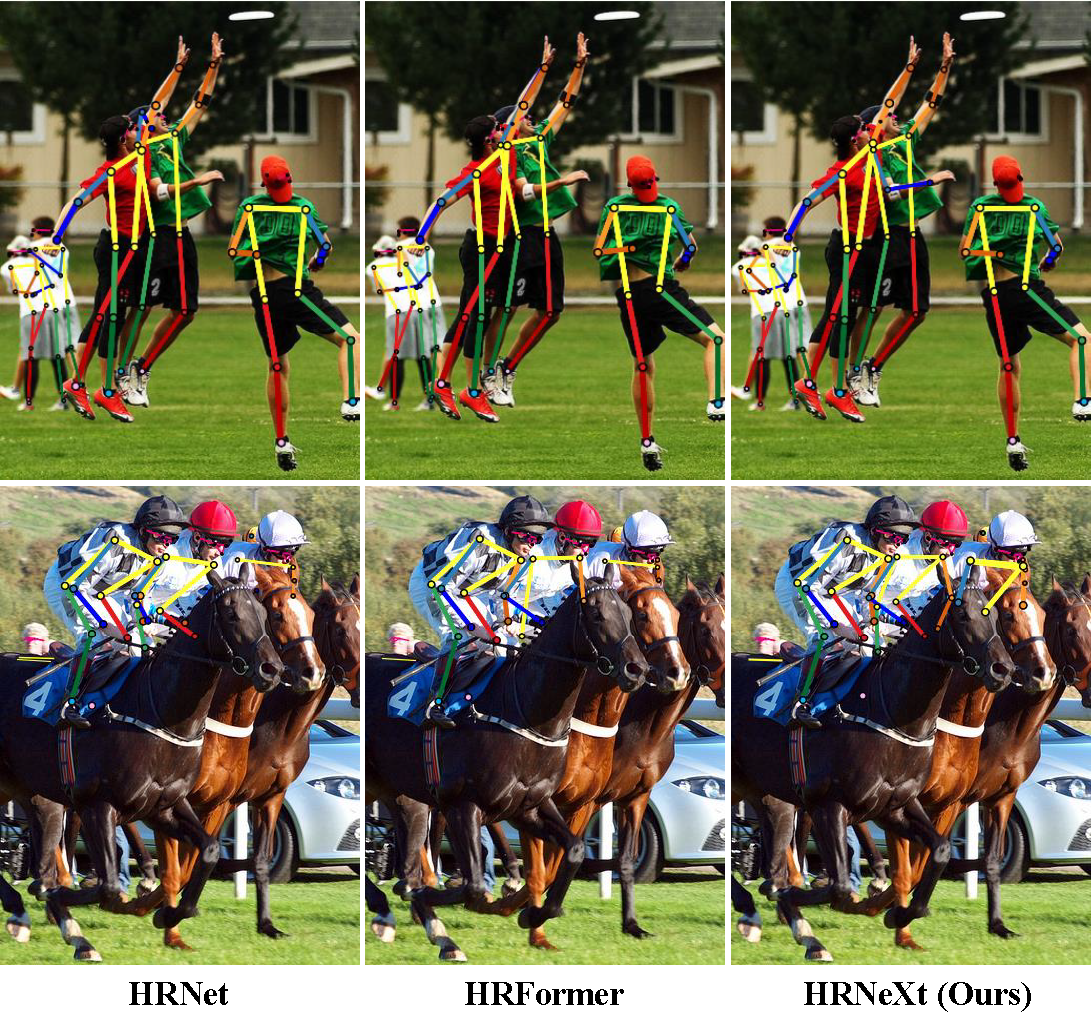This is an official repository of our paper HRNeXt: High-Resolution Context Network for Crowd Pose Estimation (published in IEEE Transactions on Multimedia). In this work, we present a novel network backbone High-Resolution Context Network (HRNeXt), which learns high-resolution representations with abundant contextual information to better estimate poses of occluded human bodies. Compared to state-of-the-art pose estimation networks, our HRNeXt is more efficient in terms of training data size, network parameters and computational cost. Experimental results show that our HRNeXt significantly outperforms state-of-the-art backbone networks on challenging pose estimation datasets with high occurrence of crowds and occlusions.
Benefiting from the superb context modeling ability, our HRNeXt can detect more keypoints and better estimate poses of occluded human bodies.
It is hoped that our HRNeXt will be a perfect substitute for other widely-used backbone networks (e.g. HRNet, HRFormer, etc.) on dense prediction tasks, since our backbone can achieve much better performance in terms of trade-off between accuracy and computational complexity.
Comparison with HRNet and HRFormer using bounding boxes from a human detector on the COCO val2017 dataset
| Backbone | Pretrain | Input Size | #Params | FLOPs | AP | AP50 | AP75 | APM | APL | AR |
|---|---|---|---|---|---|---|---|---|---|---|
| HRNet-W32 | Y | 256×192 | 28.5M | 7.1G | 0.734 | 0.895 | 0.807 | 0.702 | 0.801 | 0.789 |
| HRNet-W32 | Y | 384×288 | 28.5M | 16.0G | 0.758 | 0.906 | 0.827 | 0.719 | 0.828 | 0.810 |
| HRNet-W48 | Y | 256×192 | 63.6M | 14.6G | 0.751 | 0.906 | 0.822 | 0.715 | 0.818 | 0.804 |
| HRNet-W48 | Y | 384×288 | 63.6M | 32.9G | 0.763 | 0.908 | 0.829 | 0.723 | 0.834 | 0.812 |
| HRFormer-S | Y | 256×192 | 7.8M | 2.8G | 0.740 | 0.902 | 0.812 | 0.704 | 0.807 | 0.794 |
| HRFormer-S | Y | 384×288 | 7.8M | 6.2G | 0.756 | 0.903 | 0.822 | 0.716 | 0.825 | 0.807 |
| HRFormer-B | Y | 256×192 | 43.2M | 12.2G | 0.756 | 0.908 | 0.828 | 0.717 | 0.826 | 0.808 |
| HRFormer-B | Y | 384×288 | 43.2M | 26.8G | 0.772 | 0.910 | 0.836 | 0.732 | 0.842 | 0.820 |
| HRNeXt-S (Ours) | N | 256×192 | 9.5M | 2.5G | 0.761 | 0.906 | 0.834 | 0.728 | 0.827 | 0.813 |
| HRNeXt-B (Ours) | N | 384×288 | 31.7M | 10.8G | 0.770 | 0.911 | 0.835 | 0.732 | 0.841 | 0.820 |
| Backbone | Pretrain | Input Size | #Params | FLOPs | AP | AP50 | AP75 | APM | APL | AR |
|---|---|---|---|---|---|---|---|---|---|---|
| HRNet-W32 | Y | 256×192 | 28.5M | 7.1G | 0.631 | 0.794 | 0.690 | 0.642 | 0.631 | 0.673 |
| HRNet-W32 | Y | 384×288 | 28.5M | 16.0G | 0.637 | 0.784 | 0.690 | 0.643 | 0.637 | 0.676 |
| HRNet-W48 | Y | 256×192 | 63.6M | 14.6G | 0.645 | 0.794 | 0.701 | 0.651 | 0.645 | 0.685 |
| HRNet-W48 | Y | 384×288 | 63.6M | 32.9G | 0.650 | 0.784 | 0.703 | 0.684 | 0.650 | 0.688 |
| HRFormer-S | Y | 256×192 | 7.8M | 2.8G | 0.584 | 0.757 | 0.633 | 0.647 | 0.584 | 0.631 |
| HRFormer-S | Y | 384×288 | 7.8M | 6.2G | 0.595 | 0.756 | 0.640 | 0.641 | 0.595 | 0.642 |
| HRFormer-B | Y | 256×192 | 43.2M | 12.2G | 0.603 | 0.749 | 0.647 | 0.640 | 0.603 | 0.647 |
| HRFormer-B | Y | 384×288 | 43.2M | 26.8G | 0.625 | 0.762 | 0.660 | 0.652 | 0.625 | 0.665 |
| HRNeXt-S (Ours) | N | 256×192 | 9.5M | 2.5G | 0.631 | 0.784 | 0.681 | 0.648 | 0.631 | 0.670 |
| HRNeXt-B (Ours) | N | 384×288 | 31.7M | 10.8G | 0.671 | 0.805 | 0.716 | 0.706 | 0.672 | 0.706 |
Example checkpoint files of our HRNeXt models are available at GoogleDrive.
The code is developed and tested using python 3.7 and 8 GeForce RTX 3090 GPUs. Other python versions or GPUs are not fully tested.
- Linux (Windows is not officially supported)
- Python 3.7+
- PyTorch 1.3+
- CUDA 9.2+ (If you build PyTorch from source, CUDA 9.0 is also compatible)
- GCC 5+
- mmcv (Please install the latest version of mmcv-full)
- Numpy
- cv2
- json_tricks
- xtcocotools
a. Install mmcv, we recommend you to install the pre-build mmcv as below.
pip install mmcv-full -f https://download.openmmlab.com/mmcv/dist/{cu_version}/{torch_version}/index.htmlPlease replace {cu_version} and {torch_version} in the url to your desired one. For example, to install the latest mmcv-full with CUDA 11.3 and PyTorch 1.10.0, use the following command:
pip install mmcv-full -f https://download.openmmlab.com/mmcv/dist/cu113/torch1.10.0/index.htmlSee here for different versions of MMCV compatible to different PyTorch and CUDA versions.
Optionally you can choose to compile mmcv from source by the following command
git clone https://github.com/open-mmlab/mmcv.git
cd mmcv
MMCV_WITH_OPS=1 pip install -e . # package mmcv-full, which contains cuda ops, will be installed after this step
# OR pip install -e . # package mmcv, which contains no cuda ops, will be installed after this step
cd ..Important: You need to run pip uninstall mmcv first if you have mmcv installed. If mmcv and mmcv-full are both installed, there will be ModuleNotFoundError.
b. Install build requirements
pip install -r requirements.txtIt is recommended to symlink the dataset root to $HRNEXT/data.
If your folder structure is different, you may need to change the corresponding paths in config files.
For COCO dataset, please download from COCO download, 2017 Train/Val is needed for COCO keypoints training and validation. HRNet-Human-Pose-Estimation provides person detection result of COCO val2017 to reproduce our multi-person pose estimation results. Please download from OneDrive or GoogleDrive. Optionally, to evaluate on COCO test-dev2017, please download the image-info.
Download and extract them under $HRNEXT/data, and make them look like this:
$HRNEXT
├── configs
├── models
├── tools
`── data
│── coco
│-- annotations
│ │-- person_keypoints_train2017.json
│ |-- person_keypoints_val2017.json
│ |-- person_keypoints_test-dev-2017.json
|-- person_detection_results
| |-- COCO_val2017_detections_AP_H_56_person.json
| |-- COCO_test-dev2017_detections_AP_H_609_person.json
│-- train2017
│ │-- 000000000009.jpg
│ │-- 000000000025.jpg
│ │-- 000000000030.jpg
│ │-- ...
`-- val2017
│-- 000000000139.jpg
│-- 000000000285.jpg
│-- 000000000632.jpg
│-- ...
For CrowdPose dataset, please download from CrowdPose. Please download the annotation files and human detection results from crowdpose_annotations. For top-down approaches, we follow CrowdPose to use the pre-trained weights of YOLOv3 to generate the detected human bounding boxes. For model training, we follow HigherHRNet to train models on CrowdPose train/val dataset, and evaluate models on CrowdPose test dataset. Download and extract them under $HRNEXT/data, and make them look like this:
$HRNEXT
├── configs
├── models
├── tools
`── data
│── crowdpose
│-- annotations
│ │-- mmpose_crowdpose_train.json
│ │-- mmpose_crowdpose_val.json
│ │-- mmpose_crowdpose_trainval.json
│ │-- mmpose_crowdpose_test.json
│ │-- det_for_crowd_test_0.1_0.5.json
│-- images
│-- 100000.jpg
│-- 100001.jpg
│-- 100002.jpg
│-- ...
For OCHuman dataset, please download the images and annotations from OCHuman. Move them under $HRNEXT/data, and make them look like this:
$HRNEXT
├── configs
├── models
├── tools
`── data
│── ochuman
│-- annotations
│ │-- ochuman_coco_format_val_range_0.00_1.00.json
│ |-- ochuman_coco_format_test_range_0.00_1.00.json
|-- images
│-- 000001.jpg
│-- 000002.jpg
│-- 000003.jpg
│-- ...
All outputs (log files and checkpoints) will be saved to the working directory,
which is specified by work_dir in the config file.
By default we evaluate the model on the validation set after each epoch, you can change the evaluation interval by modifying the interval argument in the training config
evaluation = dict(interval=5) # This evaluate the model per 5 epoch.According to the Linear Scaling Rule, you need to set the learning rate proportional to the batch size if you use different GPUs or videos per GPU, e.g., lr=0.01 for 4 GPUs x 2 video/gpu and lr=0.08 for 16 GPUs x 4 video/gpu.
# train with a signle GPU
python tools/train.py ${CONFIG_FILE} [optional arguments]
# train with multiple GPUs
./tools/dist_train.sh ${CONFIG_FILE} ${GPU_NUM} [optional arguments]Optional arguments are:
--work-dir ${WORK_DIR}: Override the working directory specified in the config file.--resume-from ${CHECKPOINT_FILE}: Resume from a previous checkpoint file.--no-validate: Whether not to evaluate the checkpoint during training.--gpus ${GPU_NUM}: Number of gpus to use, which is only applicable to non-distributed training.--gpu-ids ${GPU_IDS}: IDs of gpus to use, which is only applicable to non-distributed training.--seed ${SEED}: Seed id for random state in python, numpy and pytorch to generate random numbers.--deterministic: If specified, it will set deterministic options for CUDNN backend.--cfg-options CFG_OPTIONS: Override some settings in the used config, the key-value pair in xxx=yyy format will be merged into config file. For example, '--cfg-options model.backbone.depth=18 model.backbone.with_cp=True'.--launcher ${JOB_LAUNCHER}: Items for distributed job initialization launcher. Allowed choices arenone,pytorch,slurm,mpi. Especially, if set to none, it will test in a non-distributed mode.--autoscale-lr: If specified, it will automatically scale lr with the number of gpus by Linear Scaling Rule.LOCAL_RANK: ID for local rank. If not specified, it will be set to 0.
Difference between resume-from and load-from:
resume-from loads both the model weights and optimizer status, and the epoch is also inherited from the specified checkpoint. It is usually used for resuming the training process that is interrupted accidentally.
load-from only loads the model weights and the training epoch starts from 0. It is usually used for finetuning.
Example:
# train HRNeXt-S on COCO dataset with 8 GPUs
./tools/dist_train.sh configs/coco/hrnext_small_coco_256x192.py 8You can use the following commands to test a dataset.
# single-gpu testing
python tools/test.py ${CONFIG_FILE} ${CHECKPOINT_FILE} [--out ${RESULT_FILE}] [--fuse-conv-bn] \
[--eval ${EVAL_METRICS}] [--gpu_collect] [--tmpdir ${TMPDIR}] [--cfg-options ${CFG_OPTIONS}] \
[--launcher ${JOB_LAUNCHER}] [--local_rank ${LOCAL_RANK}]
# multi-gpu testing
./tools/dist_test.sh ${CONFIG_FILE} ${CHECKPOINT_FILE} ${GPU_NUM} [--out ${RESULT_FILE}] [--fuse-conv-bn] \
[--eval ${EVAL_METRIC}] [--gpu_collect] [--tmpdir ${TMPDIR}] [--cfg-options ${CFG_OPTIONS}] \
[--launcher ${JOB_LAUNCHER}] [--local_rank ${LOCAL_RANK}]Note that the provided CHECKPOINT_FILE is either the path to the model checkpoint file downloaded in advance, or the url link to the model checkpoint.
Optional arguments:
RESULT_FILE: Filename of the output results. If not specified, the results will not be saved to a file.--fuse-conv-bn: Whether to fuse conv and bn, this will slightly increase the inference speed.EVAL_METRICS: Items to be evaluated on the results. Allowed values depend on the dataset.--gpu_collect: If specified, recognition results will be collected using gpu communication. Otherwise, it will save the results on different gpus toTMPDIRand collect them by the rank 0 worker.TMPDIR: Temporary directory used for collecting results from multiple workers, available when--gpu_collectis not specified.CFG_OPTIONS: Override some settings in the used config, the key-value pair in xxx=yyy format will be merged into config file. For example, '--cfg-options model.backbone.depth=18 model.backbone.with_cp=True'.JOB_LAUNCHER: Items for distributed job initialization launcher. Allowed choices arenone,pytorch,slurm,mpi. Especially, if set to none, it will test in a non-distributed mode.LOCAL_RANK: ID for local rank. If not specified, it will be set to 0.
Example:
# test HRNeXt-S on COCO (without saving the test results) dataset with 8 GPUS, and evaluate the mAP.
./tools/dist_test.sh configs/coco/hrnext_small_coco_256x192.py \
checkpoints/SOME_CHECKPOINT.pth 8 \
--eval mAPYou can use the following commands to compute the complexity of one model.
python tools/summary_network.py ${CONFIG_FILE} --shape ${SHAPE}SHAPE: Input size.
Example:
# compute the complexity of HRNeXt-S with 256x192 resolution input.
python tools/summary_network.py configs/coco/hrnext_small_coco_256x192.py \
--shape 256 192 \Thanks to:

